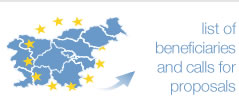Single Programming Document for the 2004-2006 period
Document Actions
The period 2004-2006 is the first period of Cohesion Policy implementation in the Republic of Slovenia. For Cohesion Policy implementation the Republic of Slovenia is treated as one NUTS II region and is eligible to the Objective 1 assistance.
The implementation of Cohesion Policy in the programming period 2004-2006 is based on the Single programming document 2004-2006 (available only in Slovene). This is one of the key programming documents for the implementation of Regional Policy worth 334.5 million Euros (239 million Euros co-financed by the EU and 95.5 million Euros by the national budget). The financial support from the structural funds represents the most important tool of economy policies for the promotion of strategic development objectives (bringing the income level closer to the EU-15 average, job creation, a balanced regional development). Structural policy is predominately realised with the help of the four structural funds: the European Regional Development Fund (ERDF) which promotes the entrepreneurial sector and competitiveness, the European Social Fund (ESF) which promotes investing in knowledge, human resources development and employment, the European Agricultural Guidance and Guarantee Fund (EAGGF) and the Financial Instrument for Fisheries Guidance (FIFG) promote the reconstruction of agriculture, forestry and fisheries. The tasks of the mentioned structural funds are presented in the table below.
Table: the EU structural funds tasks
ERDF
ESF
EAGGF
FIFG
In the Single Programming Document 2004-2006 which represents the basis for drawing on the EU structural funds in this period, Slovenia set out the following objectives:
- Average annual growth of GDP in a higher level than in the EU-15 group which would gradually bring the decrease setback in comparison to the EU average GDP per capita of the
- Growth of employment: economic growth should be reflected in job creation and preservation. A joint estimation shows that with the help of the structural funds in the 2004-2006 programming period Slovenia created at least 4000 (net) jobs
- Balanced regional development: the objective of a balanced regional development will be realised with spatial (regional) approach which should ensure that the GDP and employment growth will also increase the welfare in the less developed mainly marginal regions.
Picture: the structure of the SPD funds (EU part)
The majority of the EU funds, i.e. 131 million Euros or 54% is available in the framework of the ERDF, followed by the ESF with 73 million Euros or 31% of the available funds and the funds for agriculture, forestry and fisheries with 25 million Euros or 11% of all the available funds. 10 million Euros or 4% of all the available funds is available in the framework of the Technical assistance of the ERDF and ESF (picture).
EU Cohesion Policy is implemented on the basis of the Maastricht treaty on the basis of which the Cohesion Fund was established in 1994. The Fund is meant for the Member States with up to 90% of the EU GDP per capita average. At the moment, the Member States eligible to draw on the Cohesion Fund are Spain, Portugal, Greece and all the new Member States. The funds are distributed on the basis of the number of inhabitants, GDP per capita and the surface of the Member State by also taking into account other socio-economic factors, e.g. the deficiency in the transport infrastructure. The money is used for financing the projects in the field of environment and European transport network. The instruments of Cohesion Policy are also the loans of the European Investment Bank for financing development programmes and other funds.
In the 2004-2006 period the Cohesion Fund is based on project approach which is a difference when compared to the structural funds which are based on a programme approach. The Cohesion Fund co-finances big infrastructure and environment projects which are approved by the European Commission. The programme basis for drawing on the EU funds is the Strategic reference framework for the Cohesion Fund for each of the areas.
Before the accession of the Republic of Slovenia into the European Union the projects in the field of environment and transport were co-financed from the IPA pre-accession instrument. These projects became cohesion projects with the accession of Slovenia into the EU. In the pre-accession period the European Commission awarded funds from the Cohesion Fund for 11 environment and 5 transport projects. After the accession 7 environment and 4 transport project were approved.





